PTMEG: imports hike but exports inch down in 2023
Export inched down on the year
PTMEG exports amounted to around 74kt in 2023, down by 8.3% year on year, and the export unit price was at $2.549/kg, down by $2.283/kg on the year.
|
Export destinations of PTMEG in 2022-2023 by nations (Unit: tons) |
|||
|
Destinations |
2023 |
2022 |
YOY change |
|
Turkey |
23,618 |
17,463 |
35.2% |
|
Brazil |
20,775 |
17,279 |
20.2% |
|
UK |
7,774 |
9,042 |
-14.0% |
|
Singapore |
6,640 |
8,846 |
-24.9% |
|
South Korea |
4,537 |
4,881 |
-7.0% |
|
Thailand |
4,078 |
5,515 |
-26.1% |
|
Others |
6,560 |
17,671 |
-62.9% |
|
Total |
73,981 |
80,697 |
-8.3% |
Among major export destinations, exports to Turkey and Brazil hiked apparently on the year and those of other markets obviously fell. Rising exports to Turkey and Brazil was driven by recovering demand after the pandemic and increasing procurement from Chinese mainland after suppliers adjusted.
|
Major export destinations of PTMEG in 2022-2023 by continent (Unit: tons) |
|||
|
Destinations |
2023 |
2022 |
YOY change |
|
Asia |
40,080 |
39,838 |
0.6% |
|
South America |
20,870 |
17,500 |
19.3% |
|
Europe |
11,666 |
21,273 |
-45.2% |
|
Oceania |
606 |
812 |
-25.4% |
|
North America |
488 |
865 |
-43.5% |
|
Africa |
271 |
409 |
-33.7% |
|
Total |
73,981 |
80,697 |
-8.3% |
By continent, exports of PTMEG to South American increased prominently in 2023, mainly stimulated by growing exports to Brazil. Exports to Europe greatly weakened as supply recovered in Europe after the energy problem eased but demand for China-made PTMEG obviously diminished. The competition from other suppliers also intensified, impacting exports of PTMEG to Europe. As for Asia, although exports to Turkey increased, exports to other Asian nations reduced when supply recovered in Taiwan, China and Vietnam.
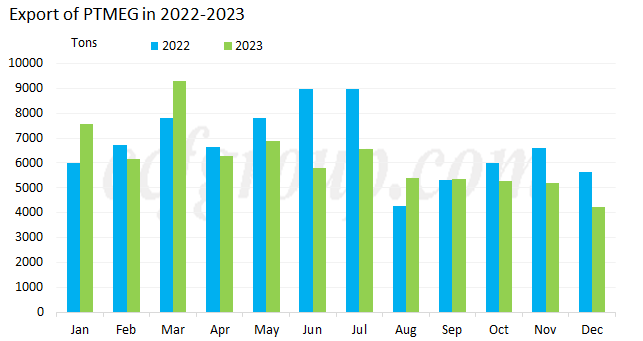
Based on the monthly exports of PTMEG, it could be seen that it was high in the first half of 2023 after demand grew but declined in the second half of year due to weakening demand.

Zhejiang was still the biggest export origin for PTMEG in 2023 but shrank apparently on the year. Some export was transferred to Ningxia and the market share of Ningxia rose to 30% in 2023. Exports from Jiangsu also apparently ascended in 2023, and the market share of Jiangsu was at 21%. But exports from Sichuan inched down. The annual export volume of other regions remained small around 7000 tons but grew by as high as around 36%.
Imports hiked
Imports of PTMEG were near 46kt in 2023, a year-on-year rise of 73.1%, and the import unit price was at $2.559/kg, down by $2.645/kg on annual basis.
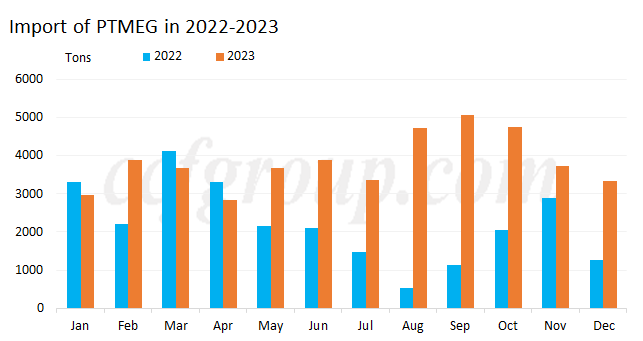
Imports of PTMEG spiked in 2023 impacted by the demand issue, low imports since May 2022 and tight supply in Chinese mainland.
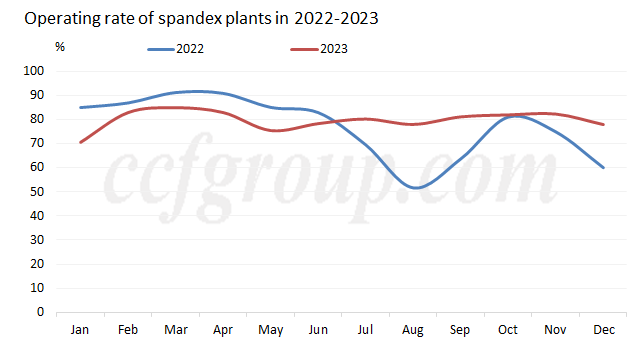
As for the operating rate of major demand field, the operating rate of spandex plants mainly shivered around 80% in 2023. Spandex plants ran stably, strongly supportive demand for PTMEG. The operating rate of spandex plants in the second half of 2023 was apparently higher than that in 2022 when many spandex plants cut or suspended production and ran at low capacity in the second half of 2022. Imports of PTMEG obviously fell in Q3 2022.
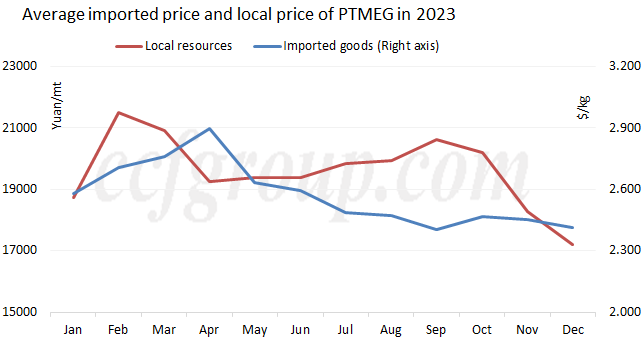
As for the price trend of average import price under USD basis and local RMB price, the trend was consistent in Q1 2023. Price of imported resources was firm in Q2. Impacted by tight supply, local price of PTMEG under RMB basis was firm in Q2 and Q3, slightly climbing up. As import volume increased and large orders rose, the price of imported goods decreased. Affected by greatly depreciating exchange rate of RMB, the price of imported goods was slightly weaker than local price under RMB basis. However, based on the converted price, the price of imported goods was medium-to-high compared with local goods under RMB basis. In Q4, price of imported goods reduced less amid cost pressure, but local goods under RMB basis decreased more with pressure from demand. The price spread between imported goods and local resources started enlarging. More downstream plants had turnaround in Nov-Dec and demand weakened. The price gap widened. With cost pressure, imports of PTMEG shrank on the month.
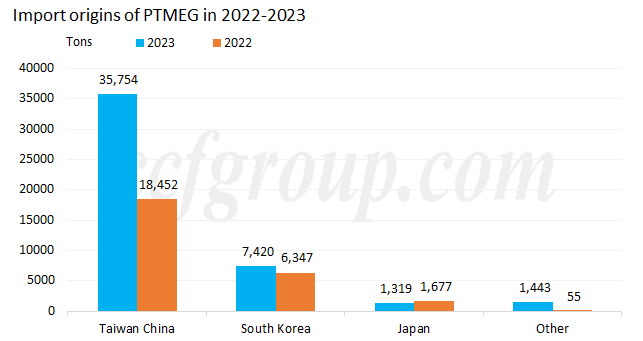
Imports from Taiwan, China rose the most apparently, and it accounted for 78% of the total import, up by around 8 percentage points on the year. Imports from South Korea slightly rose and those from Vietnam moved up prominently.
- Top keywords
- Cotton Price
- Cotton Futures Price
- Cotton Futures
- CZCE
- PTA Futures Price
- Chemical Fiber
- Polyester Prices
- Wool price
- PTA Futures
- Shengze Silk
- China
- Yarn Price
- price
- China Textile City
- Fibre Price
- Benzene Price
- Cotton
- Index
- Cotton Index
- PTA
- fabric price
- NYMEX
- Top 10
- textile industry
- Spot Cotton
- Cotton Yarn
- Polyester Price
- Futures
- PTA Price
- cotton yarn price

